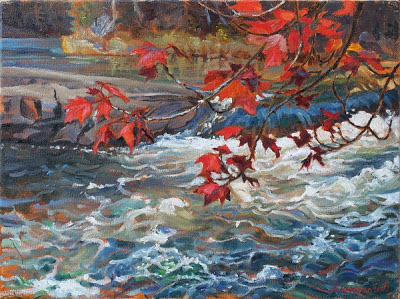Lynde Creek Mouth (oil on canvas 5 x 7 in.) Sold
19 July finds us at the mouth of Lynde Creek on Lake Ontario, 2 km southwest of Port Whitby. This is the place where we observed little Alewives struggling to cross the shallow bar to the lake in 1994.
Since then the lake has breached the bar, and sloshes in and out like a quick little tide called a seiche, now flowing into the marsh from the lake, running against us as we paddle out.
Canoeing out from the bridge at the base of the boardwalk, we occasionally saw huge tails waving slowly in the air as the giant, pig-like Carp grubbed in the mud for roots - and possibly clams if there are any left. Their activities keep the water murky and opaque. We searched submerged branches carefully for signs of Zebra Mussels and found none. Perhaps young Carp clean off young Zebras even before they can grow larger to be crunched by big Carp.
The lake shore suddenly presents us with a different world, separated from the bay of the creek by a sand bar embossed with a pattern of Goose foot prints, embroidered with ferny-leaved red runners of yellow-flowered Cinquefoil and blanketed with purple knapweed, set against silvery-leaved willow bushes. The lake is calm today, but its waves have arranged the beach with smooth pebbles. Fred finds some larger flat dark ones to skip out across the bright surface. The water is sparkling clear, until the seiche of the lake lowers its mini-tide to allow the creek to flow out.
We wrote a lot about the lake shore in my book A Place To Walk - its massive old Willow trees, blanketing Grape vines, bars, inlets and marshes, and I feel as if I've come home.
The current is very strong as we paddle briskly back, progressing slowly through the gap. We did not record the presence of Carp in Lynde Creek in 1994, but they have certainly made their mark now, and on our way back we talk about how stupid it was to leave the Carp out of our hypothesis that these Lake Ontario marshes might provide a refuge for the now rare soft bottom mussel Ligumia nasuta.
Since then the lake has breached the bar, and sloshes in and out like a quick little tide called a seiche, now flowing into the marsh from the lake, running against us as we paddle out.
Canoeing out from the bridge at the base of the boardwalk, we occasionally saw huge tails waving slowly in the air as the giant, pig-like Carp grubbed in the mud for roots - and possibly clams if there are any left. Their activities keep the water murky and opaque. We searched submerged branches carefully for signs of Zebra Mussels and found none. Perhaps young Carp clean off young Zebras even before they can grow larger to be crunched by big Carp.
The lake shore suddenly presents us with a different world, separated from the bay of the creek by a sand bar embossed with a pattern of Goose foot prints, embroidered with ferny-leaved red runners of yellow-flowered Cinquefoil and blanketed with purple knapweed, set against silvery-leaved willow bushes. The lake is calm today, but its waves have arranged the beach with smooth pebbles. Fred finds some larger flat dark ones to skip out across the bright surface. The water is sparkling clear, until the seiche of the lake lowers its mini-tide to allow the creek to flow out.
We wrote a lot about the lake shore in my book A Place To Walk - its massive old Willow trees, blanketing Grape vines, bars, inlets and marshes, and I feel as if I've come home.
The current is very strong as we paddle briskly back, progressing slowly through the gap. We did not record the presence of Carp in Lynde Creek in 1994, but they have certainly made their mark now, and on our way back we talk about how stupid it was to leave the Carp out of our hypothesis that these Lake Ontario marshes might provide a refuge for the now rare soft bottom mussel Ligumia nasuta.




Scott Reid of the MNR has since found the Endangered "Eastern Pondmussel" Ligumia nasuta - the species we were looking for - in the estuary here. The abundant Carp may have prevented predation by Muskrats, which meant there were no shell piles in the marsh - we understand that the MNR crew worked in the open water by wading and swimming.
ReplyDelete